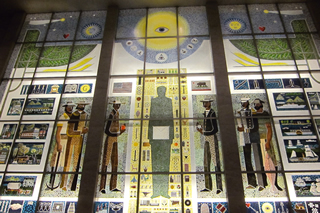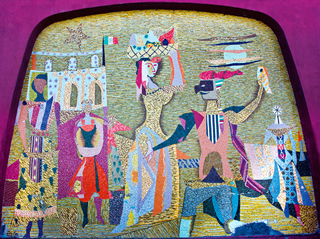Art Goes to Pieces - Page 4
 |
|
|
 |
|
|
 |
|
|
 |
|
|
Starting in the early 1950s, the Claremont artist, educator, and entrepreneur Millard Sheets began what must be the United States’ greatest series of mosaic murals—by square footage certainly, and by quality too—if you admire his ‘American Scene’ California watercolor school approach. His murals combine approachable, slightly abstracted scenes of urban life, historical imagery, and a bit of fancy with savvy design, delightful colors and textures, and a real sense of joy.
The dozens of banks his firm, Millard Sheets Design, produced for Home Savings featured murals designed by himself and/or his collaborator Susan Hertel and executed by the British-born Denis O’Connor, who also created many mosaic murals on his own. This work, found in towns and cities up and down the state, remains a treasure.
Initially sending his designs to Italy to be turned into tile, Sheets soon started his own mosaic workshop in Southern California, one of several such workshops that produced much of California’s work.
Sheets’ description of the work by the mosaicists, in his oral history for UCLA, makes clear how collaborative the art really is.
“After they reach a certain point, it becomes a very creative process, and there’s as much quality that comes out of their skill and imagination as there is in whatever we have as a basic design. The basic design isn’t going to change, but the quality of the cutting makes for the excitement within it.”
“The response to mosaics is very exciting,” Sheets said. “People like the richness of the glass and the vibration of the textures. And of course, the ideas; we’ve nearly always used symbols that would symbolize Home Savings—the family, the home.”
By the mid-1950s, mosaic artists were moving into abstract designs as well, many influenced by biomorphic Surrealism. It was, yes, another revival, mosaic artist and professor Larry Argiro announced in his 1961 book, Mosaic Art Today.
Throughout the 1950s and 1960s, many California artists worked primarily in mosaic or made mosaic a major part of their work, creating panels that could be hung on a wall, three-dimensional sculptures, or installations in homes or other buildings.
Among the more prominent is Bennie Bufano, many of whose sculptures included mosaic decoration, including his largest, the 72-foot-tall ‘Expanding Universe,’ at Timber Cove Inn on the Sonoma Coast. Bufano collaborated on the piece with mosaicists Alfonso Pardiñas and Anthony Stellon.
In Southern California, Evelyn Ackerman produced a series of delightful mosaic panels and tables, starting in the mid-1950s, featuring playful, almost child-like abstracted images, often of animals. Jean and Arthur Ames pioneered mosaic murals for the Works Progress Administration during the 1930s and continued with mosaics for decades.
In Northern California during the mid-century, artists Jean Varda, Ray Rice, and many others created both mosaic murals and wall panels.




